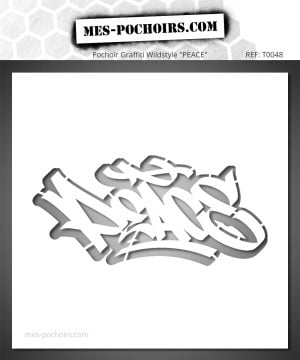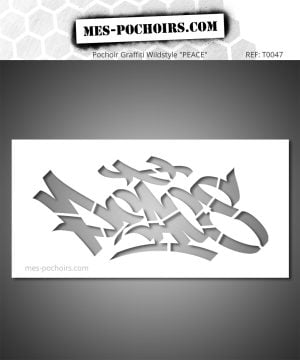The benefits of using stencils in painting: an introduction for beginners

Welcome to the fascinating world of stencil painting ! Are you ready to add a touch of art to your life, but don't know where to start? Don't panic! In this article, we'll take you step-by-step through the benefits of using stencils in painting, the materials you need, the steps to follow and tips on how to make your projects a success.
Whether you're a budding artist or a decorating enthusiast looking for new ideas, this comprehensive guide is for you. So get your apron on, get your paintbrushes ready and dive into this creative and colourful world with us!
Why use stencils for painting?
Save time and energy
The use of stencils in painting makes it possible to create complex, detailed designs in a short space of time. Stencils make the artist's work easier by eliminating the need to reproduce repetitive patterns or meticulous details by hand.
Obtain precise and consistent results
Stencils ensure that designs are created with the utmost precision. Thanks to their precise cutting, they guarantee a clean, uniform result that would be difficult to achieve without them.
Exploring new artistic styles
Stencils allow you to experiment with new artistic styles and techniques. Using stencils, beginners can easily get to grips with a variety of styles, including pop art, street art and wall murals.
-
New!
-
New!
-
New!
-
New!
The different types of stencil
Reusable stencils
Reusable stencils are made from durable materials such as plastic or mylar. They can be cleaned and reused several times, making them an economical and environmentally-friendly choice.
Disposable stencils
Disposable stencils are often made of paper or cardboard and are designed for one-off use. They are generally cheaper than reusable stencils, but are not suitable for projects that require the same design to be repeated several times.
Homemade stencils
If you can't find the perfect stencil for your project, why not create it yourself? It's possible to make bespoke stencils using card, plastic or other suitable materials. All it takes is a simple cutter and a bit of creativity!
How to choose the right stencil for your project
Stencil material
The choice of material depends on the frequency of use and the level of detail required. Plastic or mylar stencils are ideal for repeated use, while paper or cardboard stencils are more suitable for one-off use.
Stencil size and shape
The size and shape of the stencil should match the scale of your project. Choose a stencil suited to the size of the surface to be painted and the level of detail you want.
Level of detail
The level of detail in the stencil is a key consideration. Highly detailed stencils can be more difficult to use, especially for beginners. Opt for simple designs that gradually become more complex as you get to grips with the technique.
The materials you need to paint with stencils
Paint
Different types of paint can be used to create stencil designs. Acrylic and water-based paints are the most commonly used. Make sure you choose a paint that is suitable for the surface you are working on.
Brushes and rollers
Specific brushes or rollers for stencils are recommended. They enable the paint to be applied evenly and prevent smudging.
Repositionable adhesive tape and/or glue
Use adhesive tape or repositionable glue to attach the stencil to the surface to be painted. This prevents the stencil from moving while the paint is being applied.
Protective paper
To avoid paint spillage, it is advisable to protect the areas adjacent to the stencil with paper or plastic film.
Painting techniques using stencils
There are several painting techniques you can use with stencils. Here are some of the most popular:
Roller paint
Roller paint is ideal for covering large surfaces quickly and evenly. It is particularly suited to plastic or metal stencils.
Brush painting
Brush painting allows you to control the application of paint more precisely and create textural effects. It's ideal for paper stencils or small-scale projects.
Spray paint
Spray paint provides fast, even coverage and is particularly suitable for metal stencils. It's also ideal for street art and outdoor decoration projects. Recently, new odourless spray paints have made it possible to use spray paint indoors.
Steps for painting with stencils
Preparing the surface
Before you start painting, make sure the surface is clean, dry and dust-free. If necessary, apply a coat of base paint to even out the background colour.
Fixing the stencil
Position the stencil on the surface to be painted and secure it with adhesive tape or repositionable glue.
Applying paint
Apply the paint to the stencil using a suitable brush or roller. Be careful not to overload with paint to avoid smudges and spills.
Remove the stencil and leave to dry
Once the paint has been applied, carefully remove the stencil before the paint dries completely. Then allow the paint to dry according to the manufacturer's recommendations.
Tips for a successful stencil painting project
Using the dry brush technique
The dry brush technique involves removing excess paint from the brush before applying it to the stencil. This technique reduces the risk of smudges and spills.
Do not overload with paint
Apply the paint in thin, successive coats to avoid smearing and dripping. It's better to apply several light coats than one thick one.
Tester on a sample
Before starting your project, do a trial run on a piece of paper or card to familiarise yourself with the technique and check the colour rendition.
Stencil painting project ideas for beginners
- Personalise everyday objects such as mugs, canvas bags and cushions.
- Create decorative pictures for your home using geometric or floral stencils.
- Create unique patterns on the walls of your home to add character to your decor.
Conclusion
Stencils offer many advantages for beginners and experienced artists alike. They save time, produce precise results and allow you to explore new artistic styles. With a little practice and by following our advice, you can create superb stencil painting projects.
FAQ
Q1: Can I use stencils to paint on fabric? R1: Yes, you can use stencils to paint on fabric. Make sure you choose a paint that is suitable for the fabric and that you fix the stencil correctly to avoid smudging.
Q2: How do I clean a reusable stencil? R2: To clean a reusable stencil, use warm water and soap. Gently rub the stencil with a sponge or soft cloth, then rinse and leave to dry.
Q3: How do I store my stencils? R3: To preserve your stencils, store them flat and out of direct sunlight. Avoid folding or stacking them to avoid distorting them.
Q4: Can I use stencils to paint on wood? A4: Yes, you can
Use stencils to paint on wood. Make sure the wood is clean and sanded before you start, and use a paint suitable for this type of surface.
Q5 : How can I create my own stencils? A5: To create your own stencils, you can use card, plastic or other suitable materials. Draw or print your design on the chosen material, then cut it out carefully with a precision cutter or scissors.





















